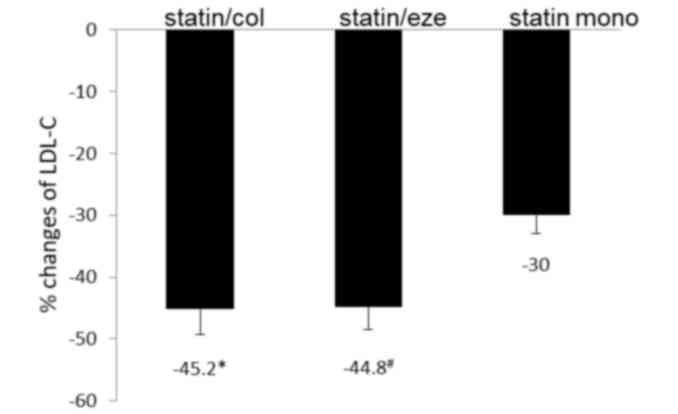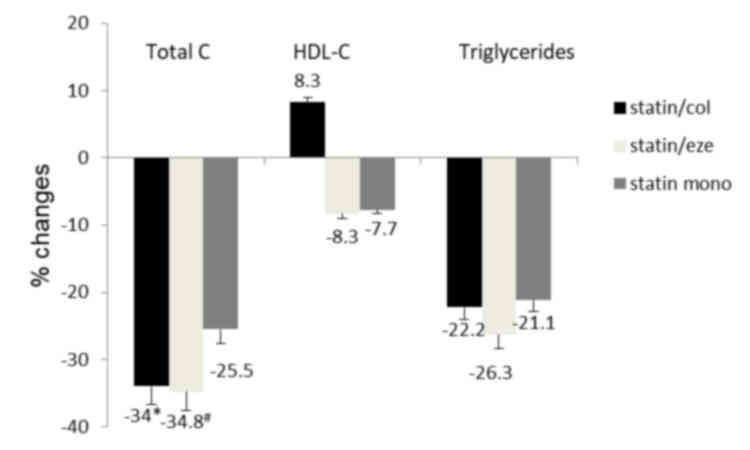|
1
|
Graham I, Cooney MT, Bradley D, Dudina A
and Reiner Z: Dyslipidemias in the prevention of cardiovascular
disease: Risks and causality. Curr Cardiol Rep. 14:709–720. 2012.
View Article : Google Scholar : PubMed/NCBI
|
|
2
|
Perk J, De Backer G, Gohlke H, Graham I,
Reiner Z, Verschuren WM, Albus C, Benlian P, Boysen G, Cifkova R,
et al: European Guidelines on cardiovascular disease prevention in
clinical practice (version 2012): The Fifth Joint Task Force of the
European Society of Cardiology and Other Societies on
Cardiovascular Disease Prevention in Clinical Practice (constituted
by representatives of nine societies and by invited experts).
Atherosclerosis. 223:1–68. 2012. View Article : Google Scholar : PubMed/NCBI
|
|
3
|
Cholesterol Treatment Trialists' (CTT)
Collaboration, . Baigent C, Blackwell L, Emberson J, Holland LE,
Reith C, Bhala N, Peto R, Barnes EH, Keech A, et al: Efficacy and
safety of more intensive lowering of LDL cholesterol: A
meta-analysis of data from 170,000 participants in 26 randomised
trials. Lancet. 376:1670–1681. 2010. View Article : Google Scholar : PubMed/NCBI
|
|
4
|
Grundy SM, Cleeman JI, Merz CN, Brewer HB
Jr, Clark LT, Hunninghake DB, Pasternak RC, Smith SC Jr and Stone
NJ: National Heart, Lung, and Blood Institute, et al:
Implications of recent clinical trials for the national cholesterol
education program adult treatment panel III guidelines.
Circulation. 110:227–239. 2004. View Article : Google Scholar : PubMed/NCBI
|
|
5
|
Davidson MH and Toth PP: Combination
therapy in the management of complex dyslipidemias. Curr Opin
Lipidol. 15:423–431. 2004. View Article : Google Scholar : PubMed/NCBI
|
|
6
|
Stone NJ, Robinson JG, Lichtenstein AH,
Merz Bairey CN, Blum CB, Eckel RH, Goldberg AC, Gordon D, Levy D,
Lloyd-Jones DM, et al: 2013 ACC/AHA guideline on the treatment of
blood cholesterol to reduce atherosclerotic cardiovascular risk in
adults: A report of the American College of Cardiology/American
Heart Association Task Force on Practice Guidelines. Circulation.
129 25 Suppl 2:S1–S45. 2014. View Article : Google Scholar : PubMed/NCBI
|
|
7
|
European Association for Cardiovascular
Prevention & Rehabilitation, . Reiner Z, Catapano AL, De Backer
G, Graham I, Taskinen MR, Wiklund O, Agewall S, Alegria E, Chapman
MJ, et al: ESC/EAS Guidelines for the management of dyslipidaemias:
The Task Force for the management of dyslipidaemias of the European
Society of Cardiology (ESC) and the European Atherosclerosis
Society (EAS). Eur Heart J. 32:1769–1818. 2011. View Article : Google Scholar : PubMed/NCBI
|
|
8
|
Davidson MH, Dillon MA, Gordon B, Jones P,
Samuels J, Weiss S, Isaacsohn J, Toth P and Burke SK: Colesevelam
hydrochloride (cholestagel): A new, potent bile acid sequestrant
associated with a low incidence of gastrointestinal side effects.
Arch Intern Med. 159:1893–1900. 1999. View Article : Google Scholar : PubMed/NCBI
|
|
9
|
Insull W Jr, Toth P, Mullican W,
Hunninghake D, Burke S, Donovan JM and Davidson MH: Effectiveness
of colesevelam hydrochloride in decreasing LDL cholesterol in
patients with primary hypercholesterolemia: A 24-week randomized
controlled trial. Mayo Clin Proc. 76:971–982. 2001. View Article : Google Scholar : PubMed/NCBI
|
|
10
|
Jones MR and Nwose OM: Role of colesevelam
in combination lipid-lowering therapy. Am J Cardiovasc Drugs.
13:315–323. 2013. View Article : Google Scholar : PubMed/NCBI
|
|
11
|
Katsiki N, Athyros VG and Karagiannis A:
Exploring the management of statin intolerant patients: 2016 and
beyond. Curr Vasc Pharmacol. 14:523–533. 2016. View Article : Google Scholar : PubMed/NCBI
|
|
12
|
Engelking LJ, McFarlane MR, Li CK and
Liang G: Blockade of cholesterol absorption by ezetimibe reveals a
complex homeostatic network in enterocytes. J Lipid Res.
53:1359–1368. 2012. View Article : Google Scholar : PubMed/NCBI
|
|
13
|
Toth PP and Davidson MH: Cholesterol
absorption blockade with ezetimibe. Curr Drug Targets Cardiovasc
Haematol Disord. 5:455–462. 2005. View Article : Google Scholar : PubMed/NCBI
|
|
14
|
Reiner Z: Combined therapy in the
treatment of dyslipidemia. Fundam Clin Pharmacol. 24:19–28. 2010.
View Article : Google Scholar : PubMed/NCBI
|
|
15
|
Špinar J, Špinarová L and Vitovec J:
IMProved reduction of outcomes: Vytorin efficacy international
trial (studie IMPROVE-IT). Vnitr Lek. 60:1095–1101. 2014.(In
Czech). PubMed/NCBI
|
|
16
|
Sando KR and Knight M: Nonstatin therapies
for management of dyslipidemia: A review. Clin Ther. 37:2153–2179.
2015. View Article : Google Scholar : PubMed/NCBI
|
|
17
|
Otokozawa S, Ai M, Asztalos BF, White CC,
Demissie-Banjaw S, Cupples LA, Nakajima K, Wilson PW and Schaefer
EJ: Direct assessment of plasma low density lipoprotein and high
density lipoprotein cholesterol levels and coronary heart disease:
Results from the Framingham Offspring Study. Atherosclerosis.
213:251–255. 2010. View Article : Google Scholar : PubMed/NCBI
|
|
18
|
Foley KA, Simpson RJ Jr, Crouse JR III,
Weiss TW, Markson LE and Alexander CM: Effectiveness of statin
titration on low-density lipoprotein cholesterol goal attainment in
patients at high risk of atherogenic events. Am J Cardiol.
92:79–81. 2003. View Article : Google Scholar : PubMed/NCBI
|
|
19
|
Kotseva K, Wood D, De Backer G, De Bacquer
D, Pyörälä K and Keil U: EUROASPIRE Study Group: EUROASPIRE III: A
survey on the lifestyle, risk factors and use of cardioprotective
drug therapies in coronary patients from 22 European countries. Eur
J Cardiovasc Prev Rehabil. 16:121–137. 2009. View Article : Google Scholar : PubMed/NCBI
|
|
20
|
Reiner Ž and Tedeschi-Reiner E: Prevalence
and types of persistent dyslipidemia in patients treated with
statins. Croat Med J. 54:339–345. 2013. View Article : Google Scholar : PubMed/NCBI
|
|
21
|
Šimić I and Reiner Ž: Adverse effects of
statins-myths and reality. Curr Pharm Des. 21:1220–1226. 2015.
View Article : Google Scholar : PubMed/NCBI
|
|
22
|
Averna M, Zaninelli A, Le Grazie C and
Gensini GF: Ezetimibe/simvastatin 10/20 mg versus simvastatin 40 mg
in coronary heart disease patients. J Clin Lipidol. 4:272–278.
2010. View Article : Google Scholar : PubMed/NCBI
|
|
23
|
Conard SE, Bays HE, Leiter LA, Bird SR,
Rubino J, Lowe RS, Tomassini JE and Tershakovec AM: Efficacy and
safety of ezetimibe added on to atorvastatin (20 mg) versus
uptitration of atorvastatin (to 40 mg) in hypercholesterolemic
patients at moderately high risk for coronary heart disease. Am J
Cardiol. 102:1489–1494. 2008. View Article : Google Scholar : PubMed/NCBI
|
|
24
|
Barrios V, Amabile N, Paganelli F, Chen
JW, Allen C, Johnson-Levonas AO, Massaad R and Vandormael K:
Lipid-altering efficacy of switching from atorvastatin 10 mg/day to
ezetimibe/simvastatin 10/20 mg/day compared to doubling the dose of
atorvastatin in hypercholesterolaemic patients with atherosclerosis
or coronary heart disease. Int J Clin Pract. 59:1377–1386. 2005.
View Article : Google Scholar : PubMed/NCBI
|
|
25
|
Ballantyne CM, Blazing MA, King TR, Brady
WE and Palmisano J: Efficacy and safety of ezetimibe
co-administered with simvastatin compared with atorvastatin in
adults with hypercholesterolemia. Am J Cardiol. 93:1487–1494. 2004.
View Article : Google Scholar : PubMed/NCBI
|
|
26
|
Gudzune KA, Monroe AK, Sharma R,
Ranasinghe PD, Chelladurai Y and Robinson KA: Effectiveness of
combination therapy with statin and another lipid-modifying agent
compared with intensified statin monotherapy: A systematic review.
Ann Intern Med. 160:468–476. 2014. View
Article : Google Scholar : PubMed/NCBI
|
|
27
|
Tziomalos K, Karagiannis A, Mikhailidis DP
and Athyros VG: Colesevelam: A new and improved bile acid
sequestrant? Curr Pharm Des. 19:3115–3123. 2013. View Article : Google Scholar : PubMed/NCBI
|
|
28
|
Wong NN: Colesevelam: A new bile acid
sequestrant. Heart Dis. 3:63–70. 2001. View Article : Google Scholar : PubMed/NCBI
|
|
29
|
Knapp HH, Schrott H, Ma P, Knopp R, Chin
B, Gaziano JM, Donovan JM, Burke SK and Davidson MH: Efficacy and
safety of combination simvastatin and colesevelam in patients with
primary hypercholesterolemia. Am J Med. 110:352–360. 2001.
View Article : Google Scholar : PubMed/NCBI
|
|
30
|
Schrott HG, Stein EA, Dujovne CA, Davidson
MH, Goris GB, Oliphant TH, Phillips JC and Shawaryn GG: Enhanced
low-density lipoprotein cholesterol reduction and
cost-effectiveness by low-dose colestipol plus lovastatin
combination therapy. Am J Cardiol. 75:34–39. 1995. View Article : Google Scholar : PubMed/NCBI
|
|
31
|
Bays HE, Davidson M, Jones MR and Abby SL:
Effects of colesevelam hydrochloride on low-density lipoprotein
cholesterol and high-sensitivity C-reactive protein when added to
statins in patients with hypercholesterolemia. Am J Cardiol.
97:1198–1205. 2006. View Article : Google Scholar : PubMed/NCBI
|
|
32
|
Hunninghake D, Insull W Jr, Toth P,
Davidson D, Donovan JM and Burke SK: Coadministration of
colesevelam hydrochloride with atorvastatin lowers LDL cholesterol
additively. Atherosclerosis. 158:407–416. 2001. View Article : Google Scholar : PubMed/NCBI
|
|
33
|
Goldberg RB, Rosenson RS, Hernandez-Triana
E, Misir S and Jones MR: Initial combination therapy with metformin
plus colesevelam improves lipoprotein particles in patients with
early type 2 diabetes mellitus. J Clin Lipidol. 6:318–324. 2012.
View Article : Google Scholar : PubMed/NCBI
|
|
34
|
Davidson MH, Donovan JM, Misir S and Jones
MR: A 50-week extension study on the safety and efficacy of
colesevelam in adults with primary hypercholesterolemia. Am J
Cardiovasc Drugs. 10:305–314. 2010. View Article : Google Scholar : PubMed/NCBI
|
|
35
|
Ramkumar S, Raghunath A and Raghunath S:
Statin therapy: Review of safety and potential side effects. Acta
Cardiol Sin. 32:631–639. 2016.PubMed/NCBI
|
|
36
|
Jacobson TA, Armani A, McKenney JM and
Guyton JR: Safety considerations with gastrointestinally active
lipid-lowering drugs. Am J Cardiol. 99:47C–55C. 2007. View Article : Google Scholar : PubMed/NCBI
|











